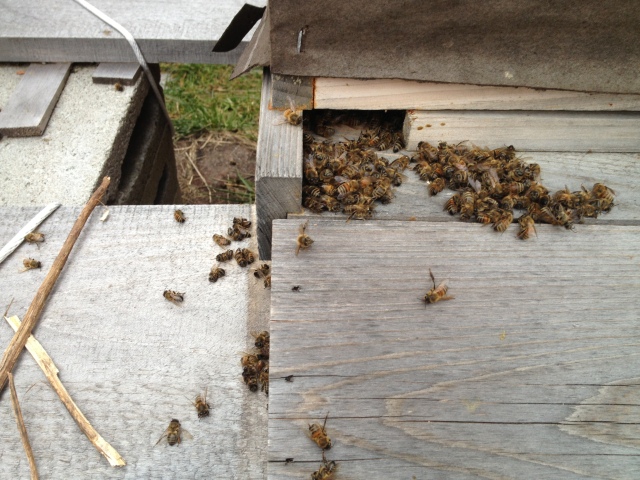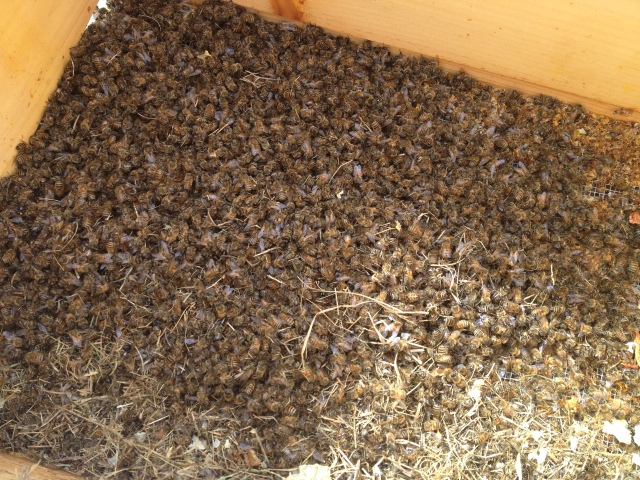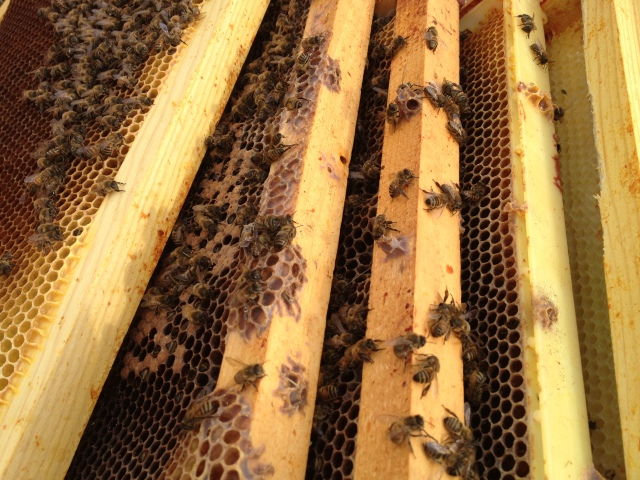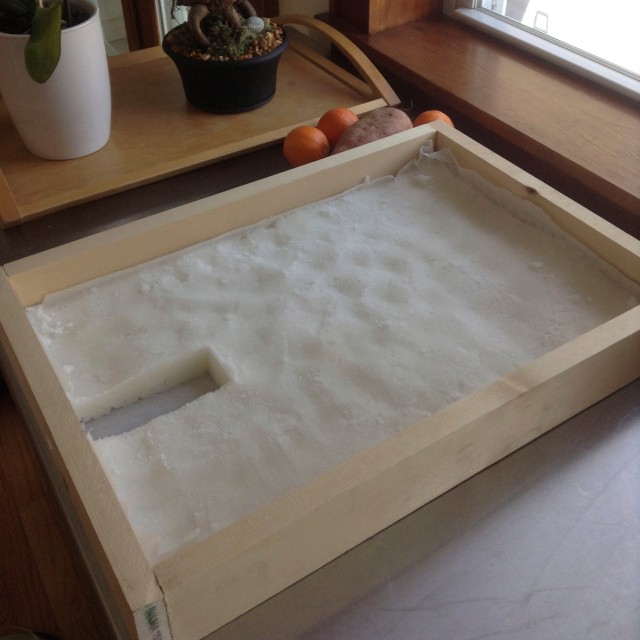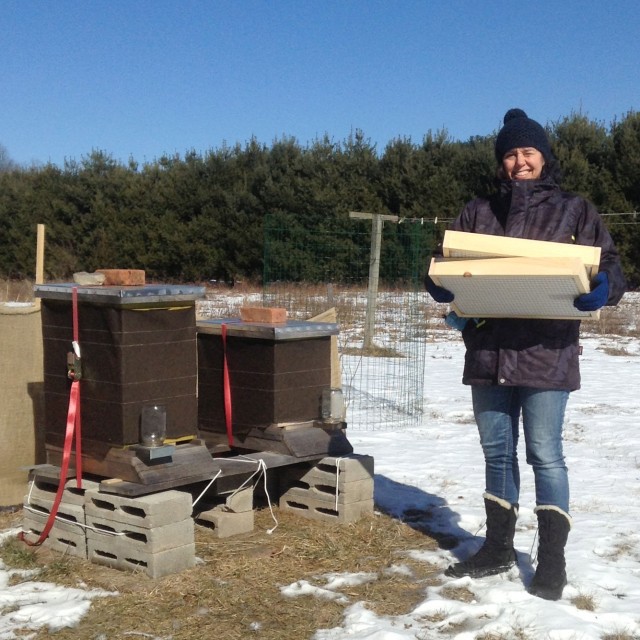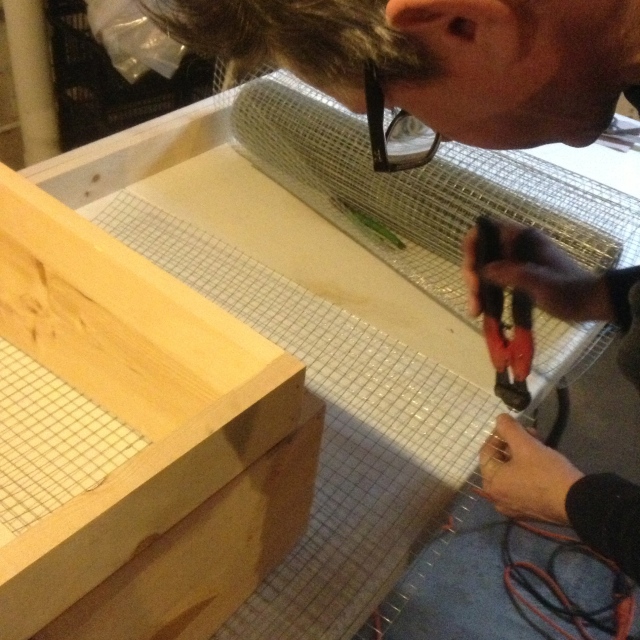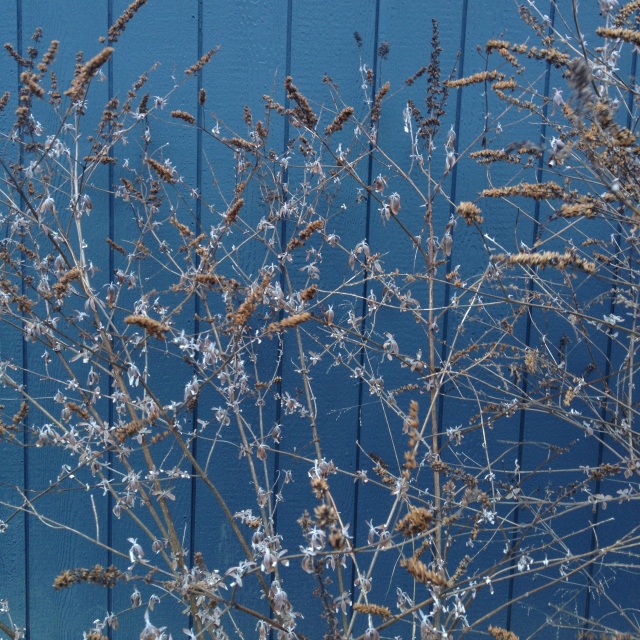
Tag Archives: Beekeeping
A Visiting Swarm
Last Wednesday Felix came running inside to tell us there was a huge group of bees hanging off of a branch in the yard. We all RAN outside as fast as we could and saw that it was, indeed a large bunch of bees hanging, shoulder-high, on a branch very near our actual beehive.
I remembered that swarms are not dangerous because they have no hive to defend so we went up close to examine it. It was really amazing to see this huge mass of bugs all clinging together. Jem & I ran to assemble an unused beehive to catch the swarm, as we headed back, they all seemed to be taking flight and within a few seconds we realized they were flying up up and over the top of a tall pine tree towards the woods.
It was the perfect height for us to catch it if we had only gotten there in time.
They’ve just left their other home because it was too crowded there (swarming is a natural part of life for honeybees), after they find a nice place to hang out for a short while, they send out scout bees to find a new home. When a particular number of scout bees return recommending the exact same location, then they all take flight together.
“The term ‘swarming’ is applied to the act of a family of bees leaving their home to establish a new home elsewhere.” –The ABC and XYZ of Beekeeping” A.I. Root, 1878
The other side.

Below is a video of them taking off.
This is where we moved the beehive to before we installed the new package of bees in April, they seem to like it better here. This is immediately to the left of where the swarm was.
Cousin Alex was visiting! and can be heard yelling to the bees in the video ‘Where are you going!?’
Long live the Queen!
 The hive that swarmed lost their queen when she led the workers to a new location (see my brief blog post on that here). BUT when we opened the hive this week we saw that there were eggs and ‘brood’ which means that the worker bees have MADE a new queen, she has mated (!) and is laying eggs. Bee books say that queens can lay up to 1500 eggs a day in the high season, this is a bit hard to comprehend. In any case, we were so relieved to see that the colony is thriving and would continue after the swarming. Whether they make it through the winter is another matter entirely.
The hive that swarmed lost their queen when she led the workers to a new location (see my brief blog post on that here). BUT when we opened the hive this week we saw that there were eggs and ‘brood’ which means that the worker bees have MADE a new queen, she has mated (!) and is laying eggs. Bee books say that queens can lay up to 1500 eggs a day in the high season, this is a bit hard to comprehend. In any case, we were so relieved to see that the colony is thriving and would continue after the swarming. Whether they make it through the winter is another matter entirely.
Extracting Honey
 We extracted our first honey this past week! It was really fun. Here’s an empty comb in all it’s mathematical beauty & precision.
We extracted our first honey this past week! It was really fun. Here’s an empty comb in all it’s mathematical beauty & precision.
This is the frame (the wooden part) filled with capped honey. The bees cap the honey with wax to seal it. The comb is irregular because we only put a half sheet of wax foundation into each frame and let the bees do the rest. Master beekeeeper Chris Harp of Honeybee Lives taught us that.
Here we are uncapping the comb. This basically involves cutting off the wax so that the honey inside can be drained or spun out in an extractor.
Jem & Felix are spinning the extractor, it works on centrifugal force. The uncapped comb with honey inside faces the outside of the barrel and the honey spills out as the frame is turned.
When all the frames are done we opened the spigot at the bottom and the honey poured into a clean bucket with a fine filter fitted on top. The filter just ensures that no wax makes it into the honey. The honey itself is still raw and untreated.
Here’s the honey dripping into the filter.
The honey!! Note the light color. it may be Catalpa or clover honey, we’re not sure. it is very flavorful and clover honey is supposed to be mild so we don’t really know where they got their nectar.
We thought these little bottles would make nice gifts, they hold 8 ounces each so we ended up with about 7 lbs total. The little bear was a gift from Megan at Hudson Valley Bee Supply where we get lots of our supplies.
Our ladies seemed to really loves these drumstick allium. I think I’ll plant more this fall.
 Summer in the Catskills has a lot to offer, and Felix was a huge help with our adventures in honey collecting.
Summer in the Catskills has a lot to offer, and Felix was a huge help with our adventures in honey collecting.
Amazing vintage beekeping videos.
This is a series of beekeeping videos made in 1979 about ‘skep beekeeping’ in Germany. They are really awesome and worth watching if you are interested in beekeeping. It is especially cool to see how they used to keep bees in the ‘olden days’ since I imagine a lot of this knowledge is now lost. These master beekeepers don’t use gloves, smoke the bees with a special pipe and are masters of all sorts of cool old crafts related to skep-making. Skeps are basically inverted baskets with an entrance for bees. They can be easily moved for pollinating and winter protection. They are so well-made that they can last as long as 100 years. Amazing craftsmanship is at work. The videos have a very slow pace and an English narrator with a wonderfully Monty-Python-esque quality to them. Enjoy!
Heathland Beekeeping on YouTube from the late 1970s, click below to see videos…
1 – Spring Work in a Heather Skep Apiary
2 – Preparations for the Swarming Period in a Heather Skep Apiary
3 – Work in a Heather Skep Apiary during the Prime Swarming Period
4 – Work in a Heather Skep Apiary during the Cast Swarming Period
5 – Summer Work during the Heather Blossom in a Skep Apiary
6 – Autumn Work in a Heather Skep Apiary
7 – Harvest of Heather Honey in a Skep Apiary
8 – Bees’ Wax Pressing in a Traditional Apiary
Master beekeeper Georg Klindworth in the skep apiary.
A new name for this blog?
You may have noticed that I changed the name of the blog to ‘Monkey’s Wedding’. This is a phrase that my late father-in-law used to describe the weather when it was raining and sunny at the same time. I always loved this phrase and the more I thought about it, the more I realized that it is a good metaphor for the existential dilemma that is so much a part of human existence. Life is beautiful but finite, both happy and sad at the same time.
They swarmed.
The bees took off right after we got the nuc from Hudson Valley Bee Supply.
They flew off into a nearby tree and then stayed there for not more than a half hour. Then they all buzzed off towards the trees and we never found them again. I guess that’s what bees do.
Her highness in the early morning.
Spring hive inspection with Roger and Jem
We were a bit overdue in doing our spring hive inspection, but luckily were helped by our friend Roger who keeps bees in Jersey City, NJ. One of our objectives was to see if we had ‘queen cells’ which would indicate that the colony was preparing to swarm. We took advantage of the help from a more experienced beekeeper to open the entire hive and really check their progress.
The day before was a very rainy Saturday in late May, 2013.
On Sunday, the sun was out and the bees seemed incredibly active and busy.
 I suggested we wait until they settled down a bit as the temp dropped. Roger & Christy said it might be better to work on the hive while lots of bees were out foraging so we went with that philosophy with much success. The bees were incredibly easy to work with. Note Roger’s BEE BOOTS.
I suggested we wait until they settled down a bit as the temp dropped. Roger & Christy said it might be better to work on the hive while lots of bees were out foraging so we went with that philosophy with much success. The bees were incredibly easy to work with. Note Roger’s BEE BOOTS.
This frame from one of the lower supers shows both worker and drone brood. I seemed to think there was a bit too much drone brood but who knows.
Those weird looking vertical things are queen cells! This means the bees are creating new queens in preparation for swarming (another way to think of it is that the hive splits in two). We either need to force that split ourselves by putting the old queen in a new hive and hoping the new baby queens work in out in the old hive OR we let them swarm, which means us losing a lot of bees. We are trying to prevent them swarming but haven’t found the ‘old’ queen (insert Liberace joke here) so haven’t accomplished that yet.
We found a lot of cross comb, where some combs are attached to each other instead of just sitting parallel. When we found this we cut off the extra comb. In some cases we cut off drone brood with actual larvae in it (sorry guys!) in some cases it was just uncapped nectar as pictured here, and in the next image.
Uncapped nectar removed from hive.
Beekeepers with MFA’s. Not sure this Roger & Jem ever pictured themselves doing this when they went to Pratt together.
When we put the hive back together, the hive looked like this for a couple of hours. By nightfall they were all back inside which was good because it was an unseasonably cold 46 that night.
The perennial garden was in full May glory but I did not see ONE honey bee in there!
That’s a lot of bees! Next weekend we will probably try to split the hive AND we’re getting a ‘nuc’ which is a brand new young colony so it’s possible we may have 3 hives in one weeks’ time. Good thing we’re moving up there, because long distance beekeeeping is proving a bit difficult.
Many thanks to Roger and Christy for their help and to Diane for taking some of these photos!
Dead Bees.
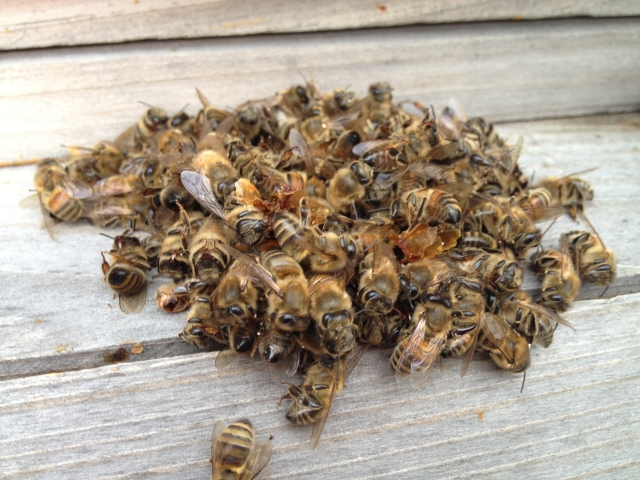
March 3rd, 2013. Looks like all the bees in hive #2 (Athena) died of starvation. Live and learn I guess but this was due to beekeeper (ie: our) error.
We fed the bees but the paper lining of the candy board was too thick(?) and they couldn’t get at the food. More pictures and the rest of the story to follow soon.
This is what I saw when I first approached the hive. I thought it was just a few dead bees at first.
All the bees were in the cells face down. I later read that this is a sure sign that they starved to death. Poor little ladies (and gents).
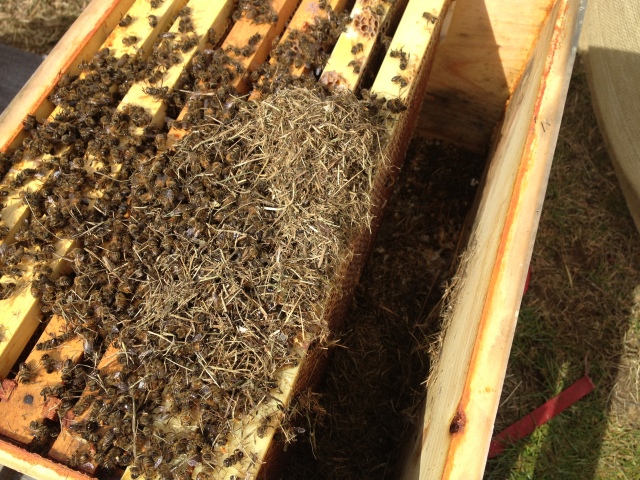 We also found evidence that a critter had been living in the hive over winter. This can be a big problem since it’s warm & there’s free food. The mouse (probably) ate honey & wax and made a moist bed at the bottom of the hive. As bad as that sounds it most likely did not kill the bees since they were up and flying 2 weeks ago.
We also found evidence that a critter had been living in the hive over winter. This can be a big problem since it’s warm & there’s free food. The mouse (probably) ate honey & wax and made a moist bed at the bottom of the hive. As bad as that sounds it most likely did not kill the bees since they were up and flying 2 weeks ago.
Bee-pocalypse at the bottom of the box.
They look perfect but they’re all dead.
 This is where the mouse ate the comb.
This is where the mouse ate the comb.
Lesson learned I suppose, late winter really is the most crucial time. The bees made it through all the cold weather but they couldn’t get at the ‘candy board’ of cane sugar that we made 2 weeks ago so they died. Here’s a picture of the candy board:
It looked gorgeous but was obviously ineffective. We scored the bottom all over, and cut a large hole in the paper that’s under the sugar so hopefully the bees in Hive 1, Amelia, can get at the sugar. Let’s hope that’s enough food to tide them over until there’s some spring forage to find.
Here I am gleefully installing the ineffective candy board 2 weeks prior:
Jem building the candy board feeders.
Filled with cane sugar and water and sitting on a sheet of wax paper.
The bee shed.





























